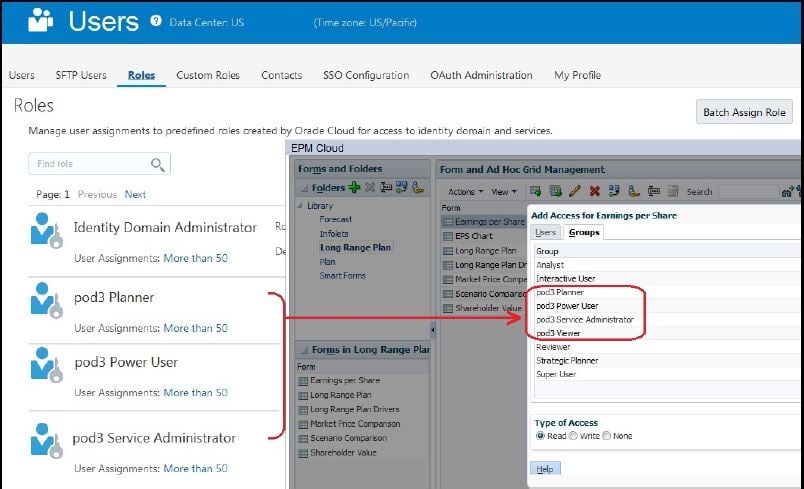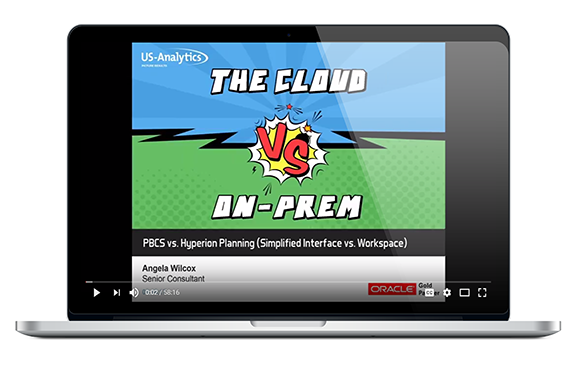The September updates for Oracle's Planning & Budgeting Cloud Service (PBCS) and Enterprise Planning and Budgeting Cloud Service (EPBCS) have arrived! This blog post outlines several new features, including REST APIs for managing users, unified user preferences, and more.
The monthly update for PBCS and EPBCS will occur on Friday, September 21 during your normal daily maintenance window.
Updates for PBCS and EPBCS
Provisioning Changes to Simplify Role Usage
The following changes that affect provisioning are included in this update.
- Only the identity domain users who are assigned to a predefined role (Service Administrator, Power User, User, and Viewer) can log into service environments.
- Users who are not assigned to predefined roles but were previously assigned to groups in Access Control will no longer be able to sign into the environment.
- Only users who are assigned to predefined roles can be added as group members in Access Control.
- Users who are not assigned to predefined roles cannot be added to groups using the importSnapshot EPM Automate command.
- Users who are not assigned to predefined roles cannot be assigned Access Control privileges (Read, Write, Execute) on application artifacts.
- The Provisioning report will show only the users who are assigned to predefined roles.
- Users who are not assigned to predefined roles are not included in the comma separated value file that results from exporting the Provisioning Report.
- Exports using Migration will not export (in Groups.CSV content of group membership) users who were not provisioned with predefined roles but were assigned to groups in Access Control.
New EPM Automate Utility Version
A new version of the EPM Automate Utility is available with this update. This version includes the following commands:
- addUsers, which creates a batch of users in an identity domain using an ANSI or UTF-8 encoded Comma Separated Value (CSV) file that was uploaded to the environment.
- assignRole, which assigns a predefined identity domain role to all the users included in an ANSI or UTF8 encoded CSV file that was uploaded to the environment.
- removeUsers, which deletes the identity domain user accounts identified in an ANSI or UTF-8 encoded CSV file that was uploaded to the environment.
- unassignRole, which removes one role currently assigned to the users whose email IDs are included in the ANSI or UTF-8 encoded CSV file that is used with this command.
REST APIs for Managing Users
You can now use REST APIs to perform these user management-related operations:
- Add users to an identity domain
- Assign users to predefined roles
- Remove users' role assignment
- Remove users from an identity domain
System Settings and Defaults Moved to Application Settings in the Simplified Interface
In a further effort to simplify how you manage administrator settings, administrators can now define all application settings and system defaults in one place in the application. For example, from the Home page, select Application, and then Settings to set email options, assign an owner to an application, or to enable currency options.
Previously, these settings were accessed from the Navigator menu on the System Settings and Defaults page. Starting with this update, the System Settings and Defaults link has been removed from the Navigator menu.
Unified User Preferences
As an end user, you can now set your preferences for many aspects of the application in a comprehensive, integrated framework in the Simplified Interface. For example, from the Home page, select Tools, and then User Preferences to set your profile picture, select members for user variables, set preferences for ad hoc options and printed reports, and so on. The preferences you set override your administrator’s settings, and persist across sessions. However, you can always change your preferences or revert to the administrator’s settings if you want to.
The new user preferences functionality is integrated across the Planning and Budgeting platform, so you benefit from using a similar user interface across its services—for example, across Planning, Financial Close, and Tax Reporting. Before, you set preferences from different parts of the application, but now you can set all your preferences in one place.
These enhancements greatly simplify how you set and manage your preferences.
Loading Data Using an Incremental File Adapter
Data Management now includes an incremental file adapter to optimize the data load process. The new Incremental adapter compares the source data file with a prior version of the source data file and identifies new or changed records and loads only this data set. The user has the option to sort the input source data file before making the comparison or they can provide a pre-sorted file for better performance.
Drilling Down from Summary Members
You can now drill down from Summary level grid members and view the detail source data that make up the number.
In order to use this feature you should select the Enable Summary Drill option in Data Management. After enabling this option and loading the data with Create Drill Region option set to Yes the Drill icon will be enabled at the summary level. Drill is limited to 1000 descendant members for a dimension.
EPBCS Only
Push Freeform Formula to Selected Subaccounts
In Strategic Modeling, the Account Forecast Freeform Formula page now includes an “Apply To” button that pushes down the freeform formula to selected subaccounts or children of the current account.
Performance Enhancements in Workforce Rules
This update includes performance enhancements to Workforce rules.
You also have the option to potentially improve performance by modifying a new Calculation Manager template, OWP_Fix Parallel_T, which enables you to specify your optimal dimension for the FIXPARALLEL statement.
Upcoming Changes
Proposed Changes to Application-level Access Control
Using Groups created in Access Control, EPM Cloud supports application-level access control for planning, consolidation and close, tax reporting, and Oracle Enterprise Data Management Cloud applications. In addition to the custom groups created in Access Control, access control screens list predefined identity domain roles (Service Administrator, Power User, User and Viewer) as groups.

With a view to simplifying security across EPM Cloud and to ensure that application-level access control can be seamlessly migrated across environments Oracle plans to remove the ability to display predefined roles as groups in access control screens. After this change, you will no longer see predefined roles listed when you search for groups in access control screens.
NOTE: The proposed change will not affect how you create and manage groups or use them for application-level access control.
Before making this change, Oracle wants to evaluate the impact, if any, that the proposed change will have on your environments. If you are concerned that the proposed change will affect your environment, please create a service request explaining your use case.
Classic Dimension Editor
With a view to allowing customers more time to familiarize themselves with the Simplified Dimension Editor, Oracle has decided to defer the removal of support for Classic Dimension Editor to a future update in 2019. Oracle will notify you at least two months prior to the removal of the feature.
Ability to Create New Composite Forms
To allow customers more time to adapt and move from composite forms to dashboards, Oracle has decided to defer the removal of the ability to create new composite forms (forms that comprise multiple simple forms) to a future update in 2019. After this update all existing composite forms can still be edited and used. This change impacts only the creation of new composite forms in the service. Oracle will notify you at least two months prior to the removal of the feature.
All customers are advised to use dashboards in place of composite forms. No more enhancements will be made to the composite forms functionality.







